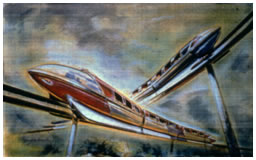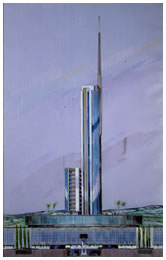
Disney design process reflects vision of its founder

What do architecture and movie-making have in common?
"The entertainment business is about telling stories, and we do that through architecture," says Bill Dye Jr., AIA, director of architecture and environmental design at Walt Disney Imagineering.
Speaking to an audience at the Institute's Washington, D.C., headquarters on February 2, Dye gave an insider's glimpse of the Disney corporation's singular approach to the creation of its buildings, landmarks, and theme parks.
 Reverse
design process
Reverse
design process
Turning the traditional concept/schematic/design development process on
its head, Disney's "Imagineers"—those responsible for creative
development, planning, design, engineering, and management of Disney's
theme parks, attractions, and real estate developments-more closely follow
the techniques of a set designer, according to Dye. First, a "blue-sky"
phase is held, wherein ideas are exchanged, followed by artists' attempts,
through elaborate sketches, to capture the mood of an attraction and the
buildings' place within it. A "story line," is then developed,
followed by full-scale physical models and finally a usable building.
"It's totally collaborative," Dye says of the Imagineers' approach to developing their ideas, likening the process to making a feature film. The 1,900-strong Imagineering staff comprises over 140 disciplines—architects chief among them—and integration is key, he adds.
It's a process that the Imagineers have refined continually in the course of developing nine theme parks in the half-century since Walt Disney first assembled the unit to bring his idea for Disneyland to life.
That history is covered in detail in the exhibition "The Architecture of Reassurance: Designing the Disney Theme Parks" (March 17–August 15 at the National Building Museum, Washington, D.C.), the title of which hints at the philosophy and motivation of a man whose architectural and planning ideas are being carried out even 35 years after his death.
"The Architecture
of Reassurance"
"Our CEO happens to have a passion for architecture," Dye said
of current Disney boss Michael Eisner. "He wants buildings to stand
the test of time." It's a passion obviously passed down from Walt
Disney himself, who, as illustrated in the exhibition's drawings, plans,
and models, relied heavily on architecture to sell his version of postwar
utopia.

Starting with Disneyland's "Main Street U.S.A." (drawn from Disney's memory of his hometown of Marceline, Mo.), the park was designed to be "reassuring"—a mix of the familiar and the fantastic—and a pedestrian-friendly reprieve from the Los Angeles sprawl that would soon encroach upon it. Duplicated at all subsequent Disneyland-style parks, Main Street buildings use a film-making technique called "forced perspective"—with a near-life-size ground floor and progressively smaller upper floors-that effectively "shrinks" the city to human scale.
Adding to the pedestrian-"friendliness" of the parks are "wienies," Disney-speak for the highly visible architectural landmarks—Fantasyland's castle, Frontierland's riverboat, Tomorrowland's rocketship—-that tourists can easily identify to gain their bearings.
The exhibition's "Simulations" gallery shows the Imagineers' facility for recreating locales, displaying drawings and models of such icons (reproduced at Disney World, Orlando) as the Eiffel Tower and the Piazza San Marco. Disney places great emphasis on its precise architectural detailing in these recreations and, in a process they describe as "plussing," attempts to "improve" on the existing construction by adding new buildings to form a convincing context.
Such simulations are now acknowledged to have influenced developers in the creation of urban shopping districts in New York, Boston, and Baltimore. But Disney had still larger plans afoot to shape the future of urban design.
 EPCOT—the
city that wasn't
EPCOT—the
city that wasn't
Flush with the success of Disneyland, its founder "wasn't going to
make the same mistake" of building his next park where a sprawling
metropolis could impinge on it, Dye noted. So he purchased 27,000 acres
in central Florida and succeeded in obtaining for it "sovereign-like"
status for the land.
Disney's ambitious plans for the land, outlined in a film he made shortly before his death in 1966, included a glass-domed and air-conditioned "city of tomorrow" set amidst a 1,000-acre site. The metropolis would be laid out like a wheel (not unlike Disneyland and subsequent Disney parks), the hub to contain a hotel and convention center, stores, theaters, restaurants, and office buildings. Encircling the hub would be concentric belts of high-density apartments, greenbelt areas, and low-density residential districts. High-speed monorails would transport commuters to the central city, and "people movers" would move them about within the city.
Disney's Experimental Prototype Community of Tomorrow (EPCOT), projected to house 20,000 people, never came to fruition as Disney had envisioned. But its mere formulation reveals Disney's emerging "New Urban" sensibility, as well as his struggle to reconcile the old world with the new.
That ethos did find expression, however, in the Disney-built town of Celebration, Fla.—opened in 1996 on 4,900 acres near Orlando—which bills itself as combining "the best ideas from the most successful towns of yesterday and the technology of the new millennium." Gone are Disney's dome, the monorail, and the high-rises. But preserved from his original vision are the emphases on safety, walkability, and "community." The town's pre-1940s residential architectural styles (residents may choose from one of six styles offered) also echo Disney's yearning to recreate an earlier era.
Into the future
Today's Disney corporation—the undisputed leader in its chosen idioms—continues
to exhibit the curious wedding of old and new characteristic of its founder.
According to Dye, the Imagineers have pioneered a four-dimensional software program, which they plan to market, that adds the element of time to the construction process. The program-used in the design of several of the rides in Disney's newly opened California Adventure-is intended to keep "unpredictability" out of the design process, which he says can constitute 50 percent of a project's "hard cost."
Nevertheless, Dye is quick to add, "we find that, right now, computer skills are no substitute for good, hard drawing skills," which he says better bring out the "emotion" of a building. "The storytelling process," Dye adds by way of descriptive amplification, "is emotional."
Copyright 2001 The American Institute of Architects. All rights reserved.
![]()
|
For more information, visit Walt Disney Imagineering. |
|